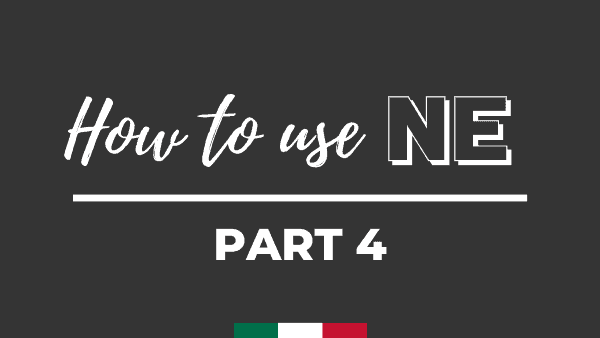The Particle NE
Lesson 2 of 4
We continue our journey to unveil all the secrets of this little grammatical monster we call NE.
This is the second Episode of Ask Manu Italiano dedicated to this topic. Make sure you watch and study Lesson 1 of 4 before moving on to this episode.
Download the PDF
No email required
NE in compound tenses
Whenever we need to use NE in a compound tenses, that is verbal tenses made up of two parts: the auxiliary verb and the past participle – NE will cause the AGREEMENT of the past particles with the noun that NE is replacing.
Some compound tenses that you are familiar with are the PASSATO PROSSIMO (the tense I used in this lesson's examples) and FUTURO ANTERIORE. The actual tense does not matter here. What matters is that it is a compound tense with a past participle!
By AGREEMENT we mean that the past participle will change its form to reflect the gender (masculine or feminine) and number (singular or plural) of the thing that NE is replacing.
▷ An example
QUANTE TORTE AVETE COMPRATO?
How many cakes have you bought?
NE ABBIAMO COMPRATE TRE.
We bought three (of them)
Since here the NE is replacing “the cakes“, which in Italian is feminine plural, the past participle of the verb has to also be feminine plural (COMPRATE).
It would be incorrect to say:
*** NE ABBIAMO COMPRATO TRE.
▷ Another example
QUANTI PANINI AVETE COMPRATO?
How many sandwiches have you bought?
NE ABBIAMO COMPRATI 50.
We bought 50 (of them).
Here the NE is replacing “the sandwiches“, which in Italian is masculine plural, so the past participle of the verb has to also be masculine plural (COMPRATI)
Learn Italian to Fluency
- The program you've been dreaming of is here
- Better than having a private tutor
- In-Depth Italian lessons for complete clarity
- Extensive pratice opportunities
- Access to our community - you are never alone!
- A true learning experience to Italian Fluency
BUT careful!
When the noun that NE is replacing is served or comes in a container, then the AGREEMENT will happen with the container, not the actual thing that we are replacing. Hold on, here's what I mean!
▷ For example
If you had too much wine and said:
HO ESAGERATO CON IL VINO…
I went overboard with the wine…
And then specified how much you had:
NE HO BEVUTI TRE BICCHIERI
I drank 3 glasses (of the wine)
NE HO BEVUTE TRE BOTTIGLIE
I drank 3 bottles (of the wine)
As you can see the agreement of the past particles changes to masculine plural in the first sentence, but it changes to feminine plural in the second,
But NE is still referring to the wine, right? Yes and no! It's referring to the container of the wine.
So we had 3 glasses/bicchieri (masculine plural) or 3 bottles/bottiglie (feminine plural).
Another scenario: NE alongside another pronoun
Whenever the NE appears alongside another pronoun, NE takes the second position and the first pronoun changes its vowel from I to E.
Say what?
Let's say that your sentence has an indirect object (let's say “to you“) and a noun which we are referring to in terms of quantity (therefore replaced by NE), this would happen:
QUANTI REGALI MI PORTI?
How many presents are you bringing me?
TI PORTO 4 REGALI.
I bring you 4 presents. (Literally: to you I bring 4 presents)
The TI here means “TO YOU“. Right?
Cool! But we could save time and words by also replacing the word REGALI. Well, the NE would need to be used here, since we are talking about the QUANTITY of a noun that we are replacing.
So we should have:
*** TI NE PORTO 4.
But we don't like the sound of that. So we say:
TE NE PORTO 4.
I bring you 4 (of them, the presents). (Literally: To you of them I bring 4).
The TI changed its vowel to E.
This is how Indirect Object Pronouns change when preceding NE
| (TO ME) | MI | -> | ME |
| (TO YOU) | TI | -> | TE |
| (TO HIM) | GLI | -> | GLIE |
| (TO HER) | LE | -> | GLIE |
| (TO US) | CI | -> | CE |
| (TO YOU GUYS) | VI | -> | VE |
| (TO THEM) | GLI | -> | GLIE |
▷ SOME EXAMPLES
So, for example, we could say:
ME NE DAI DUE (You give me two of them)
TE NE DO DUE (I give you two of them)
GLIENE DO DUE (I give him/her two of them)
CE NE DAI DUE (You give us two of them)
VE NE DO DUE (I give you guys two of them)
GLIENE DO DUE (I give them two of them)
Yes, GLIENE can mean “to him“, “to her“, “to them” PLUS NE.
There is no confusion in this, since we can only use pronouns when the noun that they are replacing is already known. In English, I can't say “him” unless we know who you are talking about. What guy? Can't say THEM, unless we know of THEY are. Same in Italian.
Download the PDF
No email required



